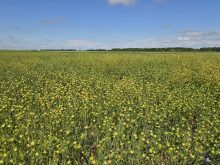SASKATOON — Russia is bolstering its presence in the flax market in a big way.
A major crush plant is set to open in that country. ASVA is building the facility in the city of Azov in Russia’s Rostov region.
ASVA is a joint project of ASTON, one of the largest food product and food ingredients manufacturers in Russia, and Vandeputte Huilerie SA, a Belgian flax processor.
Read Also

Manitoba extends Crown land rent freeze
Manitoba government links the continued rental rate freeze on grazing and forage leases to economic and environmental challenges facing the industry
It will be the largest flax processing plant in Europe, capable of processing 148,500 tonnes of the oilseed per year, said reports from the press service RBC Rostov.
To put that in perspective, Canada is expected to export 225,000 tonnes of the oilseed globally in 2025-26.
Once up and running the plant will produce 53,500 tonnes of flax oil and 90,000 tonnes of flax cake per year.
The plant is already processing seed from the 2025 crop in commissioning mode, Igor Burakov, general director of the Investment Development Agency of the Rostov Region, told RBC Rostov.
“The investor intends to export at least 70 per cent of the products to China, Turkey and the Middle East,” he said.
Russia’s Fat and Oil Union said Sodrugestvo Group of Companies, the largest oilseed crusher in Russia, is planning to build a similar-sized flax crush plant in the country.
Erwin Hanley, chair of the Flax Council of Canada, said the ASVA plant is a bit of an eye-opener.
“Certainly, the Canadian industry should take notice that someone else is coming online in terms of processing flax and trying to increase acres and flax production in Russia,” he said.
Hanley said China and Russia are starting to have a closer relationship when it comes to the grain trade. China was once a big market for Canadian flax, but not anymore.
“The last number I saw we were under five per cent of market share,” he said.
Canada’s top market for flax is the United States, and that should be safe for the time being due to geography.
“This won’t affect us in that regard,” he said.
Hanley is pretty sure Russia will be actively attempting to increase flax acres to feed the new plant being commissioned and the one in the works.
In the meantime, the plants might decrease competition in the flax seed export market because more of the crop will be consumed domestically.
Sergey Pluzhnikov, chief executive officer of Russian Pulses Analytics, said the ASVA project will be the only sizeable flax crush plant in Russia.
“This can stimulate the development of flax production in Russia not only in the south, but also in other regions,” he said in a text message.
Pluzhnikov thinks the plant is linked to the recent decision by Russia to approve a 10 per cent export duty on flax with the aim of stimulating domestic value-added processing.
Flax had been one of the few crops grown in Russia that did not have such a tax.
Pluzhnikov does not think the tax will have a dramatic impact on export volumes, but it could reduce next year’s acres in areas outside of the Rostov region where the new plant will be operating.
“Ten per cent is not much, but farmers are very pragmatic people, and if other crops turn out to be more profitable with this fee, they can change the crop rotation,” he said.
Russia is forecast to produce 1.2 million tonnes of the crop in 2025, said APK News, a news agency based in Kazakhstan.
Yevgeny Karabanov, head of the analytics committee of the Grain Union of Kazakhstan, told APK that it doesn’t make sense to develop a flax processing industry in the Black Sea region.
“Nobody needs Russian or Kazakh flaxseed oil,” he said.
China and the European Union have well-developed processing sectors and need seed rather than processed products.
In addition, he noted that EU duties on Russian flax oil make exports to that region impractical. They will jump to 50 per cent in 2026 from 20 per cent in 2025.
Russia produced 11,500 tonnes and exported 3,700 tonnes of flax oil in 2024-25, while Kazakhstan produced 4,100 tonnes and shipped out a mere 600 tonnes through the first 10 months of the year.
The main buyer for both suppliers was China.
Karabanov told APK that growers in Kazakhstan increased flax plantings by 55 per cent this year to 3.33 million acres. They are expected to harvest one million tonnes of the crop.
He said Russia’s new duty should result in increased seed exports out of Kazakhstan to the EU and China. The door was already open to the EU market due to EU duties on Russian seed and oil.
Karabanov believes the tax will cause Russian farmers to cut back on flax area, creating “ideal conditions” for expanding production in Kazakhstan and Canada, according to the APK article.
Hanley said Canada’s flax industry is built around exports. There is not much processing happening here.
“One of my biggest concerns with flax in Canada is our ability to produce the tonnes,” he said.
It is a struggle to get growers to plant 500,000 acres of the crop, while exports have plunged to 200,000 to 250,000 tonnes per year, down from 600,000 to 800,000 tonnes when the industry was thriving.
















